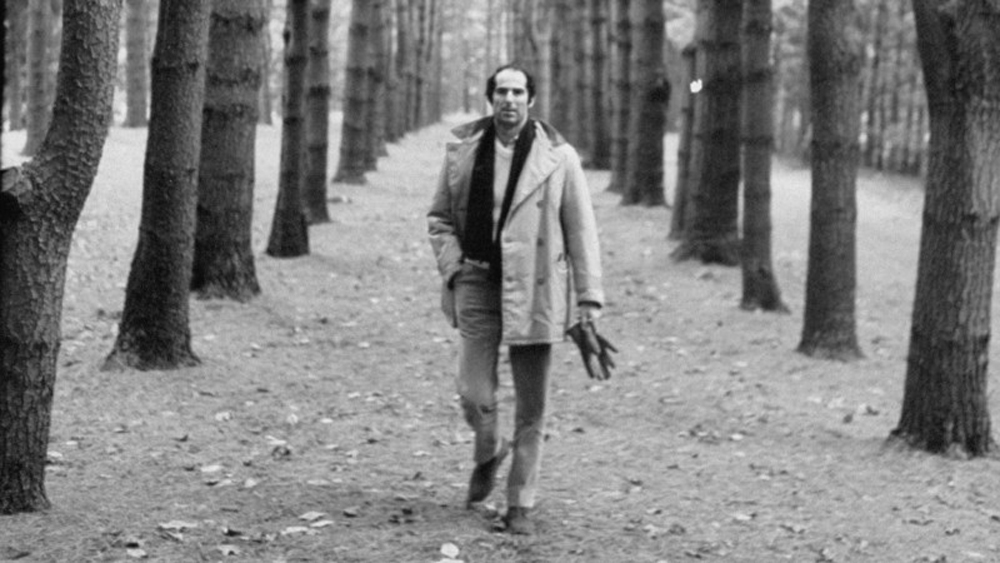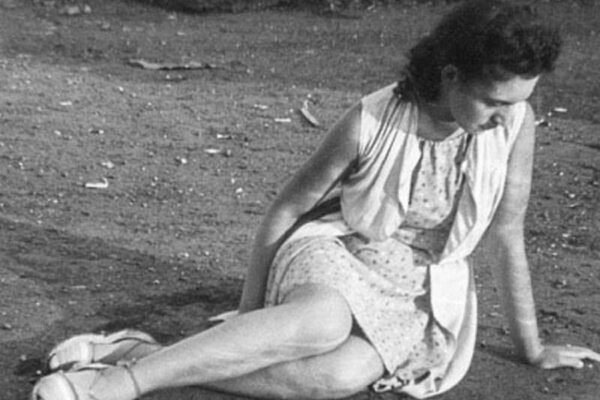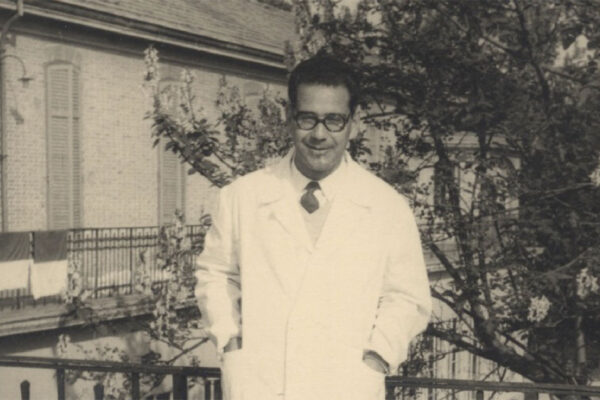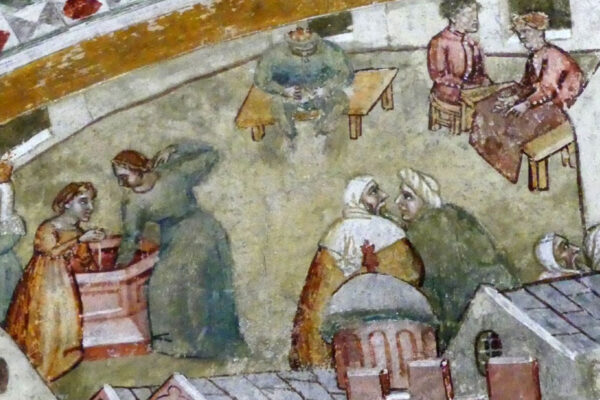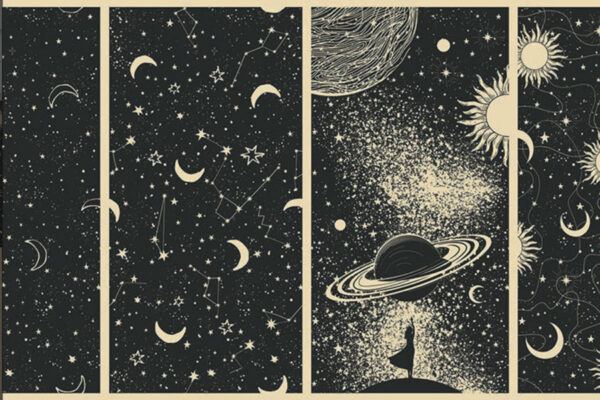We would like to remember Philip Roth (1933-2018) —in addition to his extraordinary literary production— for his pivotal role in introducing Primo Levi to the English-speaking world. In this essay, Marco Belpoliti examines the encounters between Roth and Levi that led to three versions of a memorable interview.
Translated by Paul Rosenberg for Centro Primo Levi
One of Phillip Roth’s best books is not a novel, nor even a collection of short stories; rather it is a book of interviews, entitled Shop Talk (in Italian Chiacchiere di bottega). Published in English in 2001, the volume contains a series of conversations with fellow writers. The interviews are preceded by vivid portraits of the people that Roth met, from Aharon Appelfeld to Ivan Klima, from Isaac Bashevis Singer to Milan Kundera; then there is a visit with Edna O’Brien and an exchange of letters with Mary McCarthy, a portrait of Philip Guston and a series of quick reviews of the books of Saul Bellow. These are wonderful pieces in which Roth displays not only that he is an excellent reader – and how could it be otherwise given that he is a writer? – but also that he is capable of stepping into the role of critic, a role not familiar to all authors, particularly if they are celebrities. A critic is someone who enters the depths of the books he reads, to travel through the fine web of their substance and from this travel glean general observations about literature, the world and himself. Roth demonstrates in his ‘shop talk’ that he is possessed of extraordinary humility. He never puts himself above the authors he meets and never looks down at their books: he asks questions, eye to eye. He does so as a friend, as well as an admirer, with an intensity of interest that is stunning in a writer who is so complex, rich and profound. His depth derives from his intelligence, for as sharp as he is Roth is never cynical or sentimental, and is always ready to understand.
The book, now incorporated into the collection of his essays, Why Write? Collected Nonfiction 1960-2013 (The Library of America, New York 2017), features as its opening chapter a conversation with Primo Levi, the writer whom Roth probably admired most, at least among non-Americans. It is a genuinely fascinating conversation which has an interesting story behind it, starting with the fact that this version is not the only one which you can read. It’s an interview which, notwithstanding the innumerable variations, is available in at least three different versions. The interview tells us something of the rapport between Roth and Levi, but it also informs us about the ways in which Levi thought about his work. Einaudi has recently published the third volume of the Complete Works of the Torinese writer, which bears the subtitle: Conversations, interviews and statements, and which I curated; this volume contains two of the versions of this conversation. But let’s start at the beginning, when Roth and Levi meet each other.
In London and in Torino
The first time that the two writers meet is in April of 1986 in London. Levi had gone there for a conference at the Italian Institute of Culture, which was directed by Giorgio Colombo. This was Levi’s second trip as a now acclaimed writer to an English-speaking country, after his visit to the United States the previous year. He is accompanied by his wife Lucia. At home in Torino they have left the two aged people that they cared for with the help of housekeepers and nurses: Primo’s mother and Lucia’s mother, two very old and infirm women.
Gaia Servadio arranges the meeting with the American writer. A journalist and writer herself, Servadio, who had been living in London since 1956, works with various publications, among which is “La Stampa”, with whom Levi also collaborates. Furthermore she is the daughter of a chemist who Levi had known at Siva, one Luxardo, whose mother and grandmother died at Auschwitz. The Italian journalist knows Roth. The request to meet comes from Roth, who is an admirer of Levi’s. The meeting happens at the Italian Institute of Culture, at 39 Belgrave Square. They stroll and converse. When it is over the American confides to Gaia that he has met a remarkable man. It is Wednesday, 16 April 1986.
On a September weekend of the same year Roth arrives in Torino. He had arranged to interview Levi for “The New York Times Book Review” for which he wrote. Accompanying him to the Piedmont city is his wife, Claire Bloom, the actress, who was an idol to Levi for having been the star of Limelight, which was a cult film for him. They go immediately to Siva, because Roth is curious to see the place where Levi had worked for thirty years. There they are accompanied by Paola Accardi, daughter of the owner of the business and Director of the factory. Paola had lived in England and spoke English well. She had also married an English chemist who had taken Levi’s position at the factory when he retired. Primo asks her to drive the car and to help him converse with Roth. It seems that he said to Paola: “I can’t drive and talk at the same time”. The new Director of Siva knows Primo well, not only because she is the daughter of the business owner, Federico, known as Rico (who is an important figure in Levi’s life professionally and otherwise), but also because for some years she had lived nearby the writer and so rode with him to work. Paola once told Carole Angier about how trying these car rides had been, given that Primo was almost always silent and made her feel uneasy. (The Double Bond. Primo Levi. A Biography, Farrar, Straus and Giraud, New York, 2002.) She had once hosted Levi in London, when she lived there, on which occasion she had found the chemist from her father’s factory to be lively and friendly.
The visit to the chemical company is the subject of the first part of Roth’s piece, which is a minor masterwork of psychological observation. He discovers a Levi who still has the factory in his heart, a Levi who has a nose like a dog – smell is one of the reasons, he wrote, which motivated him to become a chemist – but also that “he is focused and still like a squirrel” when he listens to those speaking to him. Roth understands that Levi’s uniqueness lies in his being more of a chemist artist than a writer chemist. This is no small observation, given that up until then no one had pointed out, at least outside the writer’s close circle, his artist’s personality. Roth also says of Levi that among the intellectually gifted artists of the 20th century, “he is probably the one who is most adapted to the surrounding environment in all its aspects”; we could use this phrase today regarding his resilient response both at Auschwitz as well as in daily life, in Torino and at Siva.
Angier and Thomson, Levi’s two biographers, relate that weekend in Torino with Philip Roth and Claire Bloom in great detail. The enthusiasm with which Levi was welcomed by the people at the factory – he had been retired for twelve years – as well as the writer’s reactions: “Here is another ghost”, he whispers in Roth’s ear upon seeing an employee of the central office, which at one time was his own workplace, approaching to greet him. The conversation then moves to Corso Re Umberto 75, in the writer’s studio, which Roth describes in his essay. Some nice photos of the visit remain, capturing them both in front of the writer’s library. Roth has a beard marked by areas of white, Levi his white goatee. Very different physically, they are different in character as well; you can see that they like each other. After all, since learning of Roth’s impending arrival, Levi had been flattered by this visit and by the proposed interview for such an important American journal. He was right to feel so, as it would go a long way towards consolidating his fame in that country, which was already growing due to translations, recognitions, reviews, and his visit to the USA for interviews and conferences. Primo is quite taken with Claire, not only because she is a famous actress and a beautiful woman, but because she displays a sensibility that impresses the Italian writer. The following day they visit Torino, have lunch together, and go to Angelo Pezzana’s bookstore, the Luxemburg, where Roth signs copies of his books. Dinner at Cambio, the classic Torinese restaurant, seals the pleasure of their time together.
In Levi’s studio they speak about many things. Little to none of this conversation is part of the interview, because – and here is the interesting thing, as Domenico Scarpa noticed – the interview was not recorded, and neither did Roth frantically take notes on a pad: everything was done in writing and from afar. After they parted, Roth had the job of sending a series of questions, and Levi that of responding in writing. This isn’t to say that what Roth saw and understood in this second meeting with the Torinese chemist doesn’t play a part in the published conversation. With a curious, even greedy eye, Roth came to understand many things about Levi and then closely read his books, such that he formed a precise idea about the personality of the writer and also in part of the man. This is apparent in the questions which he would send rather quickly, given that the interview was published little more than a month later in the American journal, on 12 October 1986.
Both of them are attentive listeners to the other, even if in the introduction to the conversation Roth attributes this quality only to Levi. But those who read Shop Talk will notice this capacity in the American: knowing how to listen to the other in such a way as to capture the inflections, the tones of voice, the most important passages. Writers, he states in the interview with Levi, like human beings in general, are divided into two categories, “those who know how to listen and those who are not capable of it”. These two are of the first type. Roth also knows how to see. His formidable observational skill is worth more than many critical readings in taking the measure of Levi’s literary personality: “In his body and his face one glimpses – in a way that doesn’t happen with the majority of men – the body and face of the past child”. Levi’s curiosity, a fundamental trait of his writings, is the tip of the iceberg of his more private personality. Roth also adds another powerful observation: “His readiness for reflection is almost palpable; insight vibrates within him like a small interior flame”. This comment allows us to understand how the body is an important element in Levi’s personality, a way of being that we connect with the readiness of intellect and insight, which itself is a way of catching things on the fly: he definitely has a nose. Perhaps here Roth is speaking not only of Levi, but also of himself.
When they part on Monday, 8 September, the American writer notices something sad in his newfound friend, which confirms for him intuitions he’d had in London during their previous encounter. Levi had not divulged any information about the depression which had gripped him for some time, but Roth still sensed something like this in him, along with the sense of a personality that emanated tranquility. A quite unusual duality. The one who seems to perceive the sorrowful part of Levi with greater depth is Roth’s wife, Claire Bloom, who is more empathetic to Levi’s suffering; as we know, in the following years Roth would also suffer from depression. Claire has related to Thomson that Primo’s gaze in the moment of their parting made an impression on her. These are ex-post observations, made after Levi’s suicide, but it is evident that Claire discerned the undercurrent of pain that the Torinese friend held within himself. “I don’t know exactly what it was, but I did understand something, and Primo understood that I had understood. We experienced a strange exchange, a sort of mutual recognition, very, very strong. If Primo understood anything about himself, this I don’t know”. She feels like crying. Levi hugs Roth and says: “I don’t know which one of us is the older brother, and which the younger”. It was Primo, in fact, who was over ten years older.
The Three Interviews
The first version of the interview appeared, as was mentioned, in “The New York Times Book Review” in October of the same year. There are six questions and six answers. At the end of the month, the 26th and 27th, it also appeared in Italian, in two installments, in the daily “La Stampa”. This version is not the same as the American text. There are still six questions and answers, but there are many differences. The introduction, the story of Roth’s visit to Torino – the more literary part we might say – with Roth’s descriptions of the place, of Levi himself, of the copper wire sculptures that Levi makes for pleasure; none of these appear. Missing from the penultimate response, the one dedicated to If Not Now, When?, is the reference to writers such as Joseph Roth, Singer, Malamud, Potok. A reference to the final chapter of If This Is A Man, “The Story of Ten Days”, is also cut. On the other hand there is something extra in the version that appears in the Torino daily: a reference to Levi’s doctor, who is Natalia Ginzburg’s brother, thus this quote: “he was Natalia Ginzburg’s brother: do you know her books? She is also a Levi, but not my relative”. A curious detail, given that it was Natalia herself who told Primo of her and Pavese’s refusal to publish If This Is A Man at Einaudi. Levi feels free to let this be known to Roth.
The difference between the two published texts has a specific reason. There exists one main text from which both are derived. It is composed of 18 typed pages, containing 10 pages of questions and 8 pages of answers edited on a computer by Levi. Roth’s questions are in English and Levi’s answers are in Italian, with some English inserted, expressions which Levi has translated directly for Roth. These, then, are the three interviews.
Between the version in “The New York Times Book Review” and that presented in Shop Talk (2001) there a various differences: corrections and clarifications. The version included in Complete Works volume III comes from Why Write? (2017), and is itself further corrected by Roth as compared to the two previous publications (and thus also different from the Italian translation contained in Chiacchiere di bottega from 2004). There are important but not decisive changes which are part of the author’s ordinary rethinking and rereading; all the translations into Italian are by Norman Gobetti.
The visit to Torino did not produce, therefore, an oral conversation but rather a written one. Thus it involved an exchange of written texts. Certainly the talk in Levi’s studio and other conversations along the road, at the restaurant, while in transit and at Siva, had generated questions, but the questions and the answers were all written.
Levi later sent a copy of the complete exchange, with Roth’s questions and his responses on the computer, to Einaudi, and for many years it was kept in the file of his correspondences with his editor, who as it happens is also Roth’s Italian editor, who has retranslated and republished Roth’s first works published previously in Italy.
In the volume of Complete Works that collects 140 interviews out of over 300 recorded, we find included both the typed version from Levi (with the questions in English and their translations) as well as the one that appeared in “The New York Times Book Review”; however this is presented in the final version that appears in Why Write?, as requested by Roth via his American agent. Meanwhile the “La Stampa” version of the conversation can be read on the journal’s online archive, as well as in the collection Primo Levi. Conversations and Interviews 1961-1987, which I edited for Einaudi in 1997.
Responses to Philip Roth
This is the title given to the typed manuscript by Roth and Levi that is included in Complete Works. The manuscript is the broadest exchange between the two writers that we have available. What are the main differences with the other two versions? In the one which appeared in “The New York Times Book Review” there are six questions and answers; the same number each are in the “La Stampa” version. In the version published in Shop Talk one more question and answer are included, which are also found in Responses to Philip Roth, and are taken from there.
The question deals with the subject of Jewish identity, which by no coincidence is one of the central themes of the book; there are six Jewish writers discussed by Roth in the book, of whom he interviewed four (Levi, Appelfeld, Klima and Isaac Bashevis Singer). Roth mentions a recent publication in the “New York Review of Books”, a piece by the historian Arnaldo Momigliano about the Jews of the Piedmont, where it is noted that this group was less a part of Italian life than they thought. Roth asks him: how much do you believe yourself to be part of Italian life? And then: to what extent do you remain an impurity, “the grain of salt or mustard seed”? Has that sense of separateness gone away? This is no small question, given that in the last period of Levi’s life the definition of Jewish writer came to be added to that of witness and of writer-chemist. Levi accepted this with a certain resistance. After all, this idea came about after the publication of If Not Now, When?, where the story of a band of Jewish partisans is the central element of the novel, the only one that Levi wrote drawing on both fiction and history. Levi’s response is that he does not see a contradiction between the two things: belonging to a specific community and being an element that gives flavor (salt and mustard). The Italian Jews, he replies, have made a great contribution to Italian life, while remaining faithful to their own tradition. Roth’s question overlooks a paradigm shift which the American writer certainly could not have fully grasped, that of Levi as an anti-fascist writer, an anti-Nazi and anti-Fascists resister, who in the 1980s became the Jewish writer of the Shoah.
In the answer there is an interesting annotation, which while restored in this version of the interview, does not appear in the previously published Shop Talk or Roth’s last American book of non-fiction: the idea of “frontier writers”, a group which Levi feels himself to be part of; he cites: Naipaul, Duras, Gordimer, Rushdie, Canetti, Kundera, all from other countries, and from Italy: Rigoni Stern (“he belongs to an archaic German minority”), Tomizza, a Slovene, Bassani, a Jew and Sciascia, a Sicilian: “All told – he says – to possess two traditions, as is the case for the Jews, but not only for them, is a treasure for writers, and not only for writers”. The reference to his position between science and literature, the “two cultures” of C. P. Snow, is also missing. Another small detail regards his relationship with Israel. In the manuscript Levi writes: “in Italy there is practically no antisemitism, rather, Judaism has come to be seen with interest and for the most part with sympathy, even if “conflicting sentiments” are developing towards Israel”. In the translation the Italian “contrastanti” becomes: “ambiguous”. The question of his relationship with Israel is yet another question within the Jewish Italian Primo Levi. Without getting in to too much detail, there are still other parts present in the manuscript Responses to Philip Roth which appear interesting but which were not included in the other two interviews. The reference to Solzenicyn and his book Ivan Denisovic and to the film The Bridge On the River Kwai, both cited where they speak about doing good work at the Lager. Then there is a question of Roth’s which has disappeared, where he cites a long passage from If This Is A Man which is dedicated to unhappiness, and is one of the most fascinating philosophical and psychological reflections in the book. Roth defines it as “the geometry of unhappiness”, a subject certainly present in his own novels. In his response Levi points out how his work in the factory “kept me in touch with the world of real things”. This is a subject about which he was very insistent, a sort of Levian “realism”. Missing also is Roth’s reference to Joyce, to his “Here Comes Everybody”, which also figures in his novels.
There are eight questions and answers in this manuscript; one does not appear in any publication, and is only found here. It regards Levi’s interest for chemistry and for varnishes. Roth asks him about his favorite authors, about Thomas Mann. He mentions The Search For Roots, the anthology which is not yet translated into English nor almost any other language, not even today, and doesn’t even appear in The Complete Works of Primo Levi (Liverlight Publishing Corporation), edited by Ann Goldstein. The American writer asks him about authors who had been an influence, authors he had read: Eliot, Rabelais, Conrad, Sholem Aleichem, Saint-Exupéry. Levi responds that his interest in varnishes was casual at first, but subsequently grew stronger. And that, in his view, there is no correlation between his enthusiasm for varnishes and that for literature. He also explains his love for Mann, not only for The Magic Mountain, but also Joseph and His Brothers, published in Italy before the German author was banned by the Fascists for his political views. Levi’s father had brought it home and he had devoured it. Then there is the passion for Aldous Huxley: his books were the first that Levi read in English; but he gave up on Huxley when he moved towards mysticism. He then continues the answer by reproducing the list of books and authors that appear in The Search For Roots; Conrad merits particular attention: a model in confronting nature as friend-enemy.
The following question instead finds a place in all of the various versions of the interview. It elaborates on the subject of the varnishes. Roth had visited Siva, and, as he explains in the introduction to the interview published in “The New York Times Book Review”, this is an important aspect of Levi’s identity. In the question from the manuscript, present in the other two versions, Roth speaks of Sherwood Anderson, the writer who worked in a varnish factory, which he then left for his literary career. Levi replies that he did not know this about Anderson. In his answer he instead mentions Italo Svevo, a Jew from Trieste who converted to Catholicism. He talks about Moravia, who was his relative. There are also lines from the manuscript which connect Zeno Cosini to Zuckerman, one of the American writer’s characters; Roth omitted these elsewhere. Levi says that there are points in common between Svevo and Roth. Svevo, adds Levi, was the director of a varnish factory which belonged to his father in law, the Società Veneziani. The parallel between Svevo and Roth is not found in the other versions, where this last part about the relationship between varnish makers and writers ends up being shorter.
Conclusions
What does Roth’s interview tell us, in the three versions that we have? First of all, we learn that Roth has truly caught some of the important aspects of Levi’s human and literary personality. As has been said, Roth has above all noted Levi’s artistic aspect; then that which connects this to the work as a chemist, which he undertook for thirty years and which saved him at Auschwitz. Roth ably brings into focus – it is the subject of the first question in all three versions – the relationship between dedication to work and shyness. Levi responds that for him shyness or inhibition “was genuine, painful and heavy; much more important to me than devotion to work”. He says: “I believe that at the time work was in effect for me a sexual compensation rather than a genuine passion”.
Another important point is the connection of the diary in “Story of Ten Days” to Robinson Crusoe. Roth seems able to enter the depths of Levi’s personality. There are moments in which Levi says things that he had never said until then; there is a confidence established with another writer, a Jew like him. He also speaks of the lack of adventure in his life, for the most part spent settled in one place since the return from Auschwitz. Levi’s comment to Natalia Ginzburg’s brother is remarkable: the year at Auschwitz is for him in technicolor, the rest of his life in Torino is in black and white.
The references to Judaism are different; they are cut from the American publication, which was probably limited by the page space assigned to the writer. Roth simplified, but also made the written dialog more compact. He cut, as has been mentioned, various literary references made by Levi, in particular the idea the he is a “frontier writer”, which offered an interesting key for interpretation. It is likely that this image conflicted too greatly with that which American readers were forming of Levi: the writer of the Shoah. This perception is highlighted by Saul Bellow in one of his correspondences with Cynthia Ozick, author of the unforgettable The Shawl: Levi was one of the few who understood the Holocaust.
In the version included in the books Roth restores the question about Levi’s Judaism, previously edited out, and the question regarding the relationship between Italian Jews and their country. Levi responds that Roth himself is, with regard to American Judaism, a mustard seed, pointing out the friction with his own religious and cultural origins that the writer had established up to that time, the year 1986.
The topic of the relationship between chemistry and literature, which stands out in Levi’s long response to the seventh, penultimate question in the manuscript Responses to Philip Roth, is shortened in the American version of the conversation. As was mentioned above, Levi answers the eighth and final question of that manuscript by making a comparison between the character Zeno Cosini in Zeno’s Conscience and Zuckerman, bringing up a subject, psychoanalysis, which is present in Roth but absent in the work of the writer from Torino. While not ignoring Freud, who he has read, Levi largely avoids psychoanalysis.
Again the theme is that of relations with women, as Levi specifies in the manuscript: Zeno “is troubled (but with much more prudishness than Zuckerman) in his relationships with women; he is afflicted by psychosomatic pains”. In this way the last question seems to refer back to the first, to the subject of sexuality. Roth, starting with Portnoy’s Complaint, has made this the center of his own fiction. It is peculiar that such a writer was Levi’s “big brother” during their two meetings at London and Torino, only a few months before the suicide of the author of If This Is A Man. The exception, as we know, always proves the rule.
In the final lines of Responses to Philip Roth, which in the manuscript are crossed out, Levi thanks Roth for the conversation and the esteem he had shown in coming to Torino. He reminds him that he still needs to put together a book of his experiences at the factory, and then he transcribes a phrase from a commentary by F. C. S. Schiller on Snark by Lewis Carroll, giving it in the original English: “It is a recognized maxim of literary ethics that none but the dead can deserve a commentary, seeing that they can no longer explain themselves or perturb the explanations of those who devote themselves to the congenial, and frequently not unprofitable, task of making plain what was previously obscure, and profound what was previously plain”. Levi himself translated this to Italian for the introduction to The Search For Roots: “È una massima riconosciuta dell’etica letteraria che soltanto gli scrittori morti devono essere commentati, visto che non sono più in grado di spiegare se stessi, né di perturbare le spiegazioni di coloro che si dedicano al compito piacevole, e talvolta non privo di utilità, di rendere chiaro ciò che prima era oscuro, e profondo ciò che prima era solo chiaro”.


